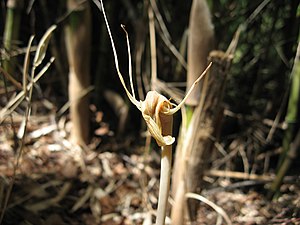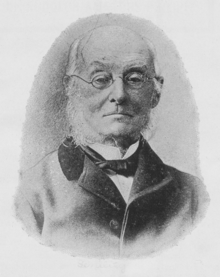Arachnitis uniflora
| Arachnitis uniflora | ||||||||||||
|---|---|---|---|---|---|---|---|---|---|---|---|---|

Arachnitis uniflora in the Región del Maule , Chile |
||||||||||||
| Systematics | ||||||||||||
|
||||||||||||
| Scientific name of the genus | ||||||||||||
| Arachnitis | ||||||||||||
| Phil. | ||||||||||||
| Scientific name of the species | ||||||||||||
| Arachnitis uniflora | ||||||||||||
| Phil. |
Arachnitis uniflora is the only species of genus Arachnitis from the family of Corsiaceae . Arachnitis uniflora is a mykoheterotrophic plant with a wide distribution area, which extends from the north of South America to the Falkland Islands, but which is only distributed in a few, disjoint , i.e. widely spaced areas. Species and genus were first described in 1864, another species described in 1972 is now mostlyclassifiedas synonymous .
features
Arachnitis uniflora is an unbranched and upright growing, leaf-green , herbaceous plant . Its rhizome or its root (the literature is ambiguous) is star-shaped, bulbous, brownish and is 10 to 15 centimeters below the ground. Each of the 4 to 17 individual roots is only 5 to 10 millimeters long and 3 to 4 millimeters wide. Lateral roots are missing, and runners are rare .
Arachnitis uniflora lives largely underground, only the rarely formed flower stalk grows above ground. Only after the root system is fully developed does the 6 to 40 centimeter long and up to 7 millimeter thick individual stalk sprout. It is of variable color, either whitish, yellowish or purple, sometimes only colored at the base and bears four to eight translucent leaves that are scaly at the base and that surround the stem in an alternating arrangement. The possibly decrepit leaves are up to 2 inches long, 1 inch wide and five- to seven-veined.
Due to its largely underground way of life, it is not known whether it is a single or multiple flowering plant. In the latter case, the plants may not bloom every year either. The flowers continue to grow continuously and to a considerable extent during the flowering period, but the flower cup always remains shorter than it is wide. The flowers remain completely intact until the seeds have spread.
The odorless, zygomorphic and threefold single flowers are terminal and almost upright, the ovary is subordinate, short and spherical. The flowers are pale pink to flesh-colored in all parts. Of the six petals (three tepals each in two petal circles ) five are linear-thread-shaped, purple single-nerved and slightly bent up, they are up to 5 centimeters long and 2 to 2.5 millimeters wide.
The top sixth petal, the labellum , is broadened at the base, tapering to a point and ending in a thread-like manner. It is 4 to 5 centimeters long, at the base 13 to 17 millimeters wide, crossed by 11 to 13 violet nerves and bent down towards the tip like a helmet over the flower base with the flower organs. The labellum is traversed inside left and right of the midrib by a dark red, thickened longitudinal furrow tapering to the outside and is rolled inward in its middle part.
The flowers are hermaphroditic, but show an extreme form of protandry , in that the anthers cover the stigmas at the time of their maturity , then fall off and so release the then ripening stigma. The six short and sub-shaped stamens , arranged in two circles, are free, the anthers open with slits lengthways. The pollen is monocolpat , the tectum is network -like. The three styluses are fused at the base and bent outwards, the scars are papillary , the papillae develop only after the anthers are shed. As pollinators are mycetophilidae suspected.
The fruits are inverted-cone-shaped capsule fruits which, when ripe, tilt down and open with three elongated columns at their front end. The numerous seeds are filet-shaped, 0.6 to 1 millimeter long and 0.06 to 0.2 millimeters wide. The seed coat consists of elongated, round cells. Although the habitat is comparatively calm, it is sometimes assumed that the seeds will spread through the wind ( anemochory ), but it is also considered possible that the plants that continue to bloom during the seed spread will continue to attract pollinators to allow the seeds to spread.
Mycoheterotrophy
Like all species of the Corsiaceae, Arachnitis uniflora has given up photosynthesis and accordingly no longer forms chlorophyll . Instead, it lives mykoheterotrophically on mycorrhizae of the fungus genus Glomus . When the plant has stored enough nutrients in its root system and starts sprouting the stem , the mycorrhiza will gradually reduce and the plant will use up its accumulated reserves instead. There are no arbuscules at all in flowering plants .
Distribution and habitat
Arachnitis uniflora has an extremely disjoint distribution area that extends over 32 degrees of latitude from the tropics to sub-Antarctic regions.
It is found at an altitude of 2500 to 2800 m in the central Andes in Bolivia , between 150 and 1241 m in western Patagonia (Argentina, Chile) and at a location at sea level in the East Falkland . This extremely wide distribution for a plant species is presumably relic and can be traced back to a pre- glacial area which was then reduced to just two larger areas due to the climatic changes after the ice age around 10,000 years ago.
Due to its extreme distribution, it populates macroclimatically very different regions, but the respective microclimate is always identical: it is always locations in dense vegetation on humus, deep soils with high humidity during the growing season. In terms of clearly separated rainy and dry seasons, it is tolerant. It appears scattered but sociable.
Arachnitis uniflora is largely dependent on intact primary forests , but can also re-establish itself in secondary vegetation that has remained undisturbed for a long time . Arachnitis uniflora is associated in the Patagonian forests of Chile cedar ( Austrocedrus chilensis ), Coihue southern beech ( Nothofagus dombeyi ), blue-green southern beech ( Nothofagus glauca ), Osmorrhiza chilensis and barberries - and Escallonia species, the Bolivian forests are mainly of Erythrina falcata , Yellow trumpet flower ( Tecoma stans ), Piper elongatum , Cedrela lilloi , Luehea species and species from the myrtle family (Myrtaceae) and the laurel family (Lauraceae).
In East Falkland it can be found on meadows and dunes on eroded sandstone, but there are no forests here.
Botanical history and systematics
Species and genus were first described in 1864 by Rudolph Amandus Philippi based on collections made by his son in 1863. Large parts of these collections were destroyed in a fire in the Philippi house and later not received. Since there was no longer a holotype , collections from the following year 1864 from the same location were proposed as a neotype in 1996 . The genus name is a nomen conservandum against the orchid genus Arachnites FW Schmidt from 1793, which is now part of the Ragwurzen ( Ophrys ).
Philippi originally assumed that the plant belonged to the orchid family (Orchidaceae), but later proposed a separate family Arachnitaceae, while other authors saw a relationship to the Burmanniaceae . With the first description of the Corsiaceae in 1878 by Odoardo Beccari , Arachnitis was then placed as a sister genus to the Corsia, whereby the Corsiaceae were temporarily only listed as a sub-taxon of the Burmanniaceae, a position that has been considered no longer tenable since 1938.
A classification as a monotypical family Arachnitaceae found hardly any advocates for a long time, but more recent results seem to justify a possible separation from the Corsiaceae into an independent family. Traudel Rübsamen reported significant differences in the morphological characteristics of the root, the gynoeceum , the fruit and, above all, the seeds. Molecular genetic studies supported this and verorteten Arachnitis near the thismiaceae and Burmanniaceae unlike the more likely the campynemataceae related Corsia .
Until the first description of Arachnitis quetrihuensis by Milan Jorge Dimitri in 1972, the genus was understood as monotypical . Today, however, the species is mostly synonymous, as Arachnitis uniflora is considered so variable that it includes Arachnitis quetrihuensis . This view was also supported by molecular genetic studies which could not distinguish between the two species.
proof
- Traudel Rübsamen: Morphological, embryological and systematic studies on Burmanniaceae and Corsiaceae (with a view of the Orchidaceae-Apostasioideae) . Berlin 1986, ISBN 3-443-64004-4 .
- Pierre L. Ibisch, Christoph Neinhuis , Patricia Rojas N .: On the Biology, Biogeography, and Taxonomy of Arachnitis Phil. Nom. cons. (Corsiaceae) in Respect to a New Record from Bolivia. In: Willdenowia , 1996, Volume 26, Issue 1/2, pp. 321-332. DOI: 10.3372 / wi.26.2616
- Laura S. Domínguez, Alicia Sérsic: The southernmost myco-heterotrophic plant, Arachnitis uniflora: root morphology and anatomy. In: Mycologia , 2004, Volume 96, Issue 5, pp. 1143-1151 ( online ).
- Paula J. Rudall, Alison Eastman: The questionable affinities of Corsia (Corsiaceae): evidence from floral anatomy and pollen morphology. In: Botanical Journal of the Linnean Society , 2002, Volume 138, pp. 315-324.
Individual evidence
Most of the information in this article has been taken from the sources given under references; the following sources are also cited:
- ↑ C. Neinhuis, P. Ibisch: Corsiaceae . In: K. Kubitzki (Ed.): The Families and Genera of Vascular Plants, Vol. 3, Lilianae , 1998, p. 200.
- ↑ a b c Pierre L. Ibisch, Christoph Neinhuis, Patricia Rojas N .: On the Biology, Biogeography, and Taxonomy of Arachnitis Phil. Nom. cons. (Corsiaceae) in Respect to a New Record from Bolivia. In: Willdenowia , 1996, Volume 26, Issue 1/2, p. 326.
- ↑ a b Ray Neyland, Melissa Hennigan: A phylogenetic analysis of large-subunit (26S) ribosome DNA sequences suggests that the Corsiaceae are polyphyletic. In: New Zealand Journal of Botany , 2003, Vol. 41, pp. 1-11.
- ↑ See e.g. B. the corresponding entry in the Detalle de la Especie - Arachnitis uniflora Phil. - Para la Flora del Conosur es - Aceptado Flora de la República Argentina - Catálogo de las Plantas Vasculares
